cooling PONTIAC BONNEVILLE 1996 Owners Manual
[x] Cancel search | Manufacturer: PONTIAC, Model Year: 1996, Model line: BONNEVILLE, Model: PONTIAC BONNEVILLE 1996Pages: 387, PDF Size: 18.71 MB
Page 63 of 387
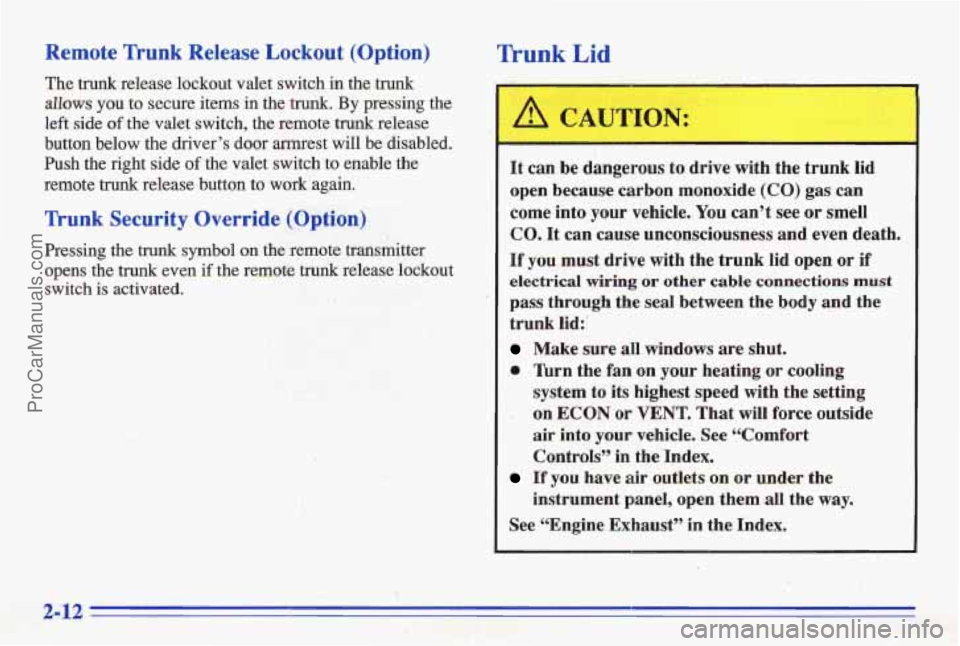
Remote Trunk Release Lockout (Option)
The trunk release lockout valet switch in the trunk
allows you to secure items in the trunk. By pressing the
left side
of the valet switch, the remote trunk release
button below the driver’s door armrest will be disabled.
Push the right side
of the valet switch to enable the
remote
trunk release button to work again.
-, Trunk Security Override (Option)
‘: .’ Psessing the trunk symbol on the remote trms~xktter
,. . opens the trunk even if the remote trunk release lockout
switch
is activated.
Trunk Lid
It can be dangerous to drive with the trunk lid
open because carbon monoxide
(CO) gas can
come into your vehicle, You can’t see or smell
CO. It can cause unconsciousness and even death,
If you must drive with the trunk lid open or if
electrical wiring or other cabl’e connections must
pass through the seal between the body and the
trunk lid:’
Make sure all windows are shut.
0 Thrn the fan on your heating or cooling
system to its highest speed with the setting
on
ECON or VENT. That will force outside
air into your vehicle. See “Comfort
Controls” in the Index.
If you have air outlets on or under the
instrument panel, open them all the
way.
See “Engine Exhaust” in the Index.
ProCarManuals.com
Page 138 of 387
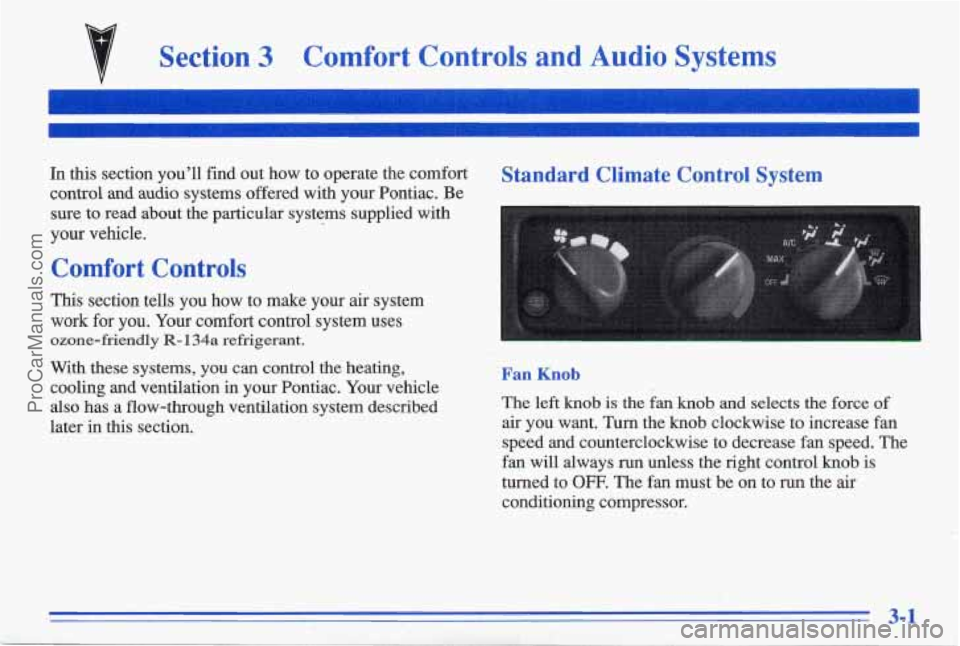
Section 3 Comfort Controls and Audio Systems
In this section you'll find out how to operate the comfort Standard Climate Control System
control and audio systems offered with your Pontiac. Be
sure to read about the particular systems supplied with
your vehicle.
Comfort Controls
This section tells you how to make yo'ur air system
work
for you. Your comfort control system uses
ozone-friendly R- 134a refrigerant.
With these systems, you can control the heating,
cooling and ventilation in your Pontiac.
Your vehicle
also has a flow-through ventilation system described
later in this section. Fan Knob
The left knob is the fan knob and selects the force of
air you want. Turn the knob clockwise to increase fan
speed and counterclockwise to decrease fan speed. The
fan
will always run unless the right control knob is
turned to
OFF. The fan must be on to run the air
conditioning compressor.
3-1
ProCarManuals.com
Page 139 of 387
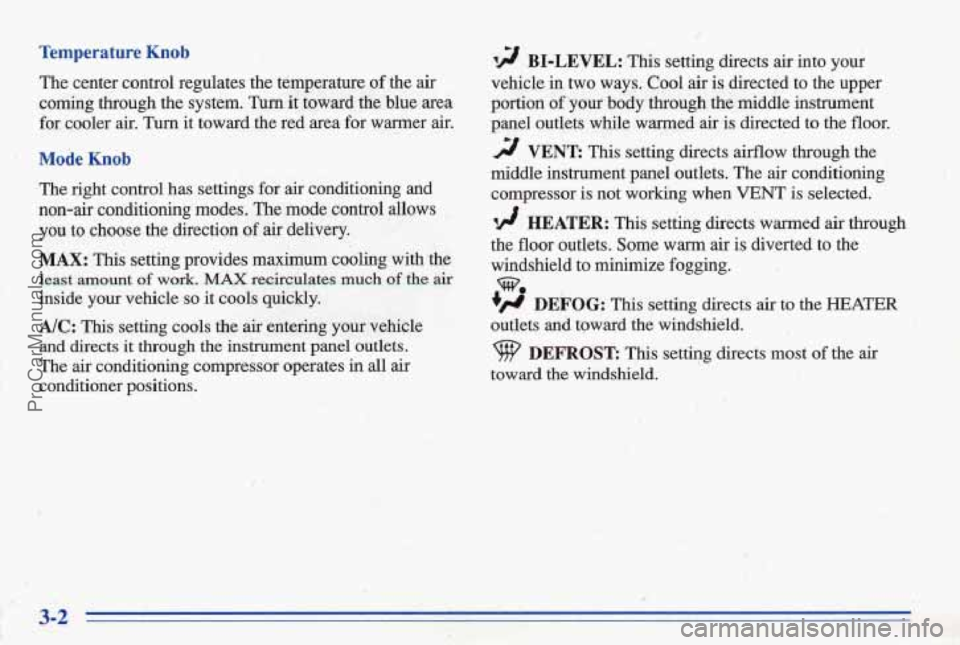
Temperature Knob 12 BI-LEVEL: This setting directs air into your
The center control regulates the temperature
of the air vehicle in two ways. Cool air is directed to the upper
coming through the system. Turn it toward the blue area
portion of your body through the middle instrument
for cooler
air. Turn it toward the red area for wmer air. panel outlets while warmed. air is directed to the floor. CI
Mode Knob
The right control has settings for air conditioning and
non-air conditioning modes. The mode control allows
you to choose the direction of air delivery.
MAX: This setting provides maximum cooling with the
least amount of work. MAX recircdates much of the air
inside your vehicle so it cools quickly.
Mc: his setting cools the air entering your vehicle
and directs it through the instrument panel outlets.
The
air conditioning compressor operates in all air
conditioner positions.
d VENT: This setting directs airflow through the
middle instrument panel outlets. The air conditioning' compressor is not
working when VENT is selected.
I! HEATER: This se&ng directs warmed air through
the floor outlets. Some warm
air is' diverted to the
windshield to minimize fogging.
w.
+H DEFOG: his setting directs &to ~e HEATER
outlets and toward the windshield.
9 DEFROST: This setting directs most of the air
toward the windshield.' . .. . .. . ,' i
3-2
ProCarManuals.com
Page 140 of 387
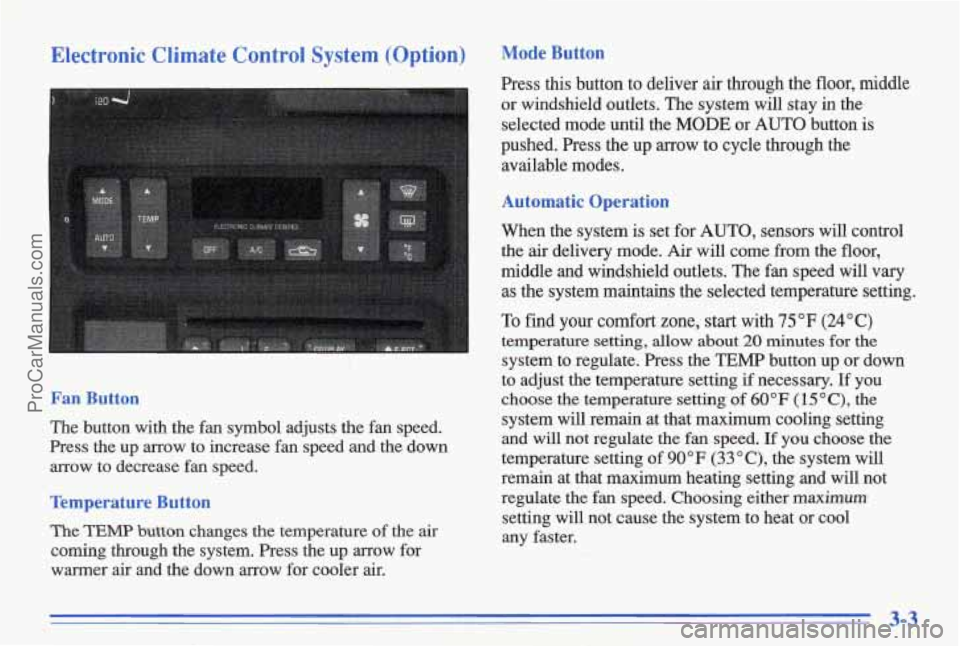
Electronic Climate Control System (Option)
Fan Button
The button with the fan symbol adjusts the fan speed.
Press the up arrow to increase fan speed and the down
arrow to decrease fan speed.
Temperature Button
The TEMP button changes the temperature of the air
coming through the system. Press the up arrow for
warmer air and the down arrow for cooler air.
Mode Button
Press this button to deliver air through the floor, middle
or windshield outlets. The system will stay in the
selected mode until the
MODE or AUTO button is
pushed. Press the up
arrow to cycle through the
available modes.
Automatic Operation
When the system is set for AUTO, sensors will control
the
air delivery mode. Air will come from the floor,
middle and windshield outlets. The fan speed will vary
as the system maintains the selected temperature setting.
To find your comfort zone, start with 75°F (24°C)
temperature setting, allow about 20 minutes for the
system to regulate. Press the TEMP button up or down
to adjust the temperature setting
if necessary. If you
choose the temperature setting
of 60°F (15 "C), the
system
will remain at that maximum cooling setting
and
will not regulate the fan speed. If you choose the
temperature setting of
90°F (33 O C), the system will
remain at that maximum heating setting and will not
regulate the fan speed. Choosing either
maximum
setting will not cause the system to heat or cool
any faster.
3-3
ProCarManuals.com
Page 142 of 387
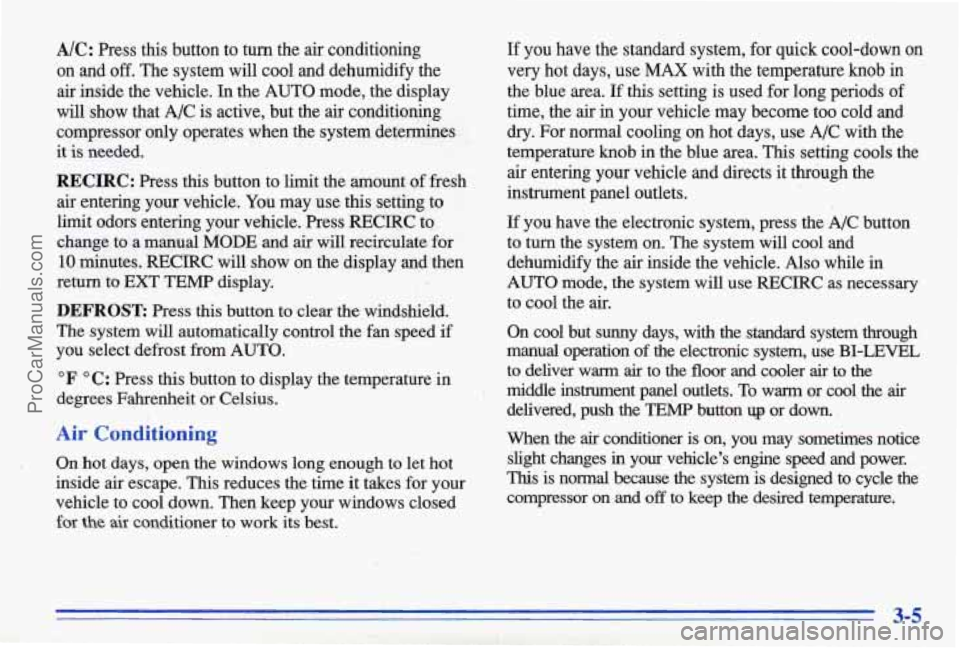
A/C: Press this button to turn the air conditioning
on and
off. The system will cool and dehumidify the
air inside the vehicle.
In the AUTO mode, the display
will show that
A/C is active, but the air conditioning
compressor
only operates when the system determines
it
is needed.
RECIRC,: Press this button to limit the amount of fresh
air entering your vehicle. You may use this setting to
limit odors entering your vehicle. Press
REClRC to
change to a manual
MODE and air will recirculate for
10 minutes. RECIRC will show on the display and then
return to
EXT TEMP display.
DEFROST: Press this button to clear the windshield.
The system will automatically control the fan speed
if
you select defrost from AUTO.
OF O C: ‘Press this button to display the temperature in
degrees Fahrenheit or Celsius.
Air Conditioning
On hot days, open the windows long enough to let hot
inside
air escape. This reduces the time it takes for your
vehicle to cool down. Then keep your windows closed
for the air conditioner to work its best.
If you have the standard system, for quick cool-down on
very hot days,
use MAX with the temperature knob in
the blue area. If this setting is used for long periods of
time, the air in your vehicle may become too cold and
dry. For normal cooling on hot days, use A/C with the
temperature
knob in. the blue area. This setting cools the
air entering your vehicle and directs it through the
instrument panel outlets.
If you have the electronic system, press the A/C button
to
turn the system on. The system will cool and
dehumidify the air inside the vehicle.
Also while in
AUTO mode, the system will use FtECIRC as necessary
to cool the air.
&1 cool but sunny days, with the standard system through
manual operation of the electron& system, use BI-LEVEL
to deliver warm air to the floor and cooler air to the
middle instrument panel outlets. To warrn or cool the
air
delivered, push the TE- button up or down.
When the air conditioner is on, you may sometimes notice
slight changes
in your vehicle’s engine speed and power.
This is normal because the system is designed to cycle the
cornpressor on
and off to keep the desired temperature.
ProCarManuals.com
Page 143 of 387
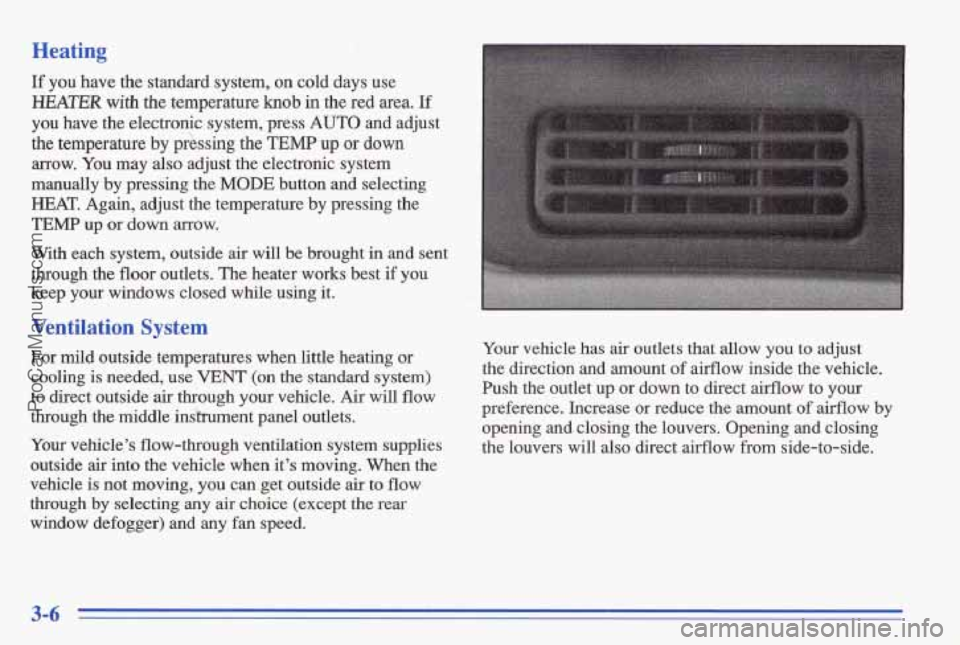
Heating
If you have the standard system, on cold days use
HEATER with the temperature knob in the red area. If
you have the electronic system, press AUTO and adjust
the temperature by
p;essing the TEMP up or down
arrow. You may also adjust the electronic system
manually by pressing the
MODE button and selecting
HEAT. Again, adjust the temperature by pressing the
"EMF up or down arrow.
With each system, outside air
will be brought in and sent
through the
floor outlets. The heater works best if you
keep your windows closed while using it.
Ventilation System
For mild outside temperatures when littkheating or
cooling is needed, use
VENT (on the standard system)
to direct outside air through your vehicle. Air will flow
through the middle instrument panel outlets.
Your vehicle's flow-through ventilation system supplies
outside
air into the vehicle when it's moving. When the
vehicle
is not moving, you can get outside air to flow
through
by selecting any air choice (except the rear
,window defogger) and any fan speed. Your
vehicle has air outlets that allow
you to adjust
the direction and amount
of airflow inside the vehicle.
Push the outlet up or down to direct airflow to your
preference. Increase or reduce the amount of airflow by
opening and closing the louvers. Opening and closing
the louvers will
also direct airflow from side-to-side.
ProCarManuals.com
Page 191 of 387
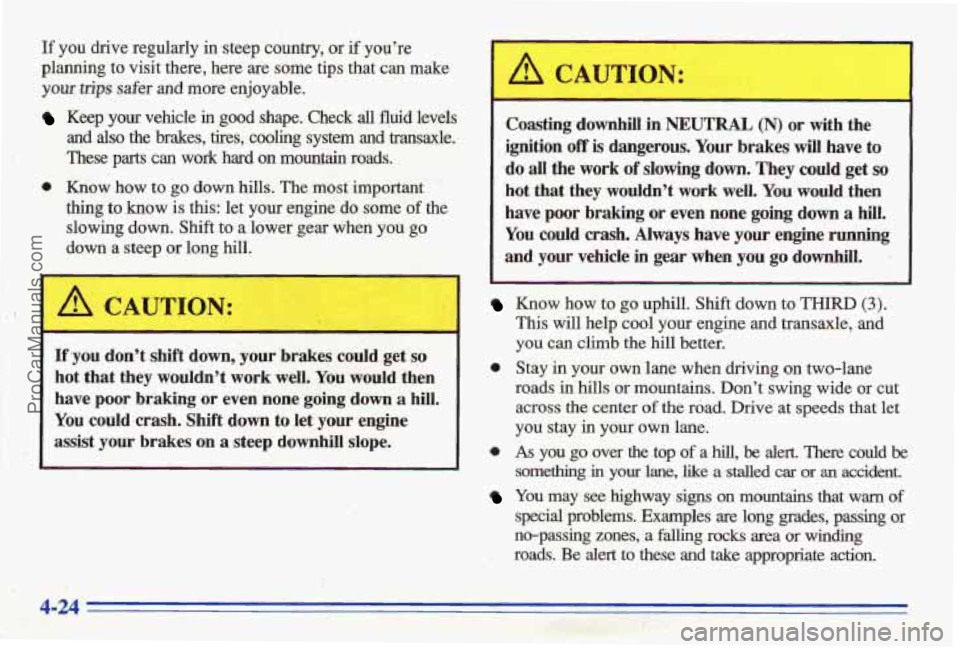
~f you drive regularly in steep country, or if you’re
planning to visit there, here
are some tips that can make
your trips safer and more enjoyable.
Keep you vehicle in good shape. Check all fluid levels
and also the brakes, tires, cooling system and transaxle.
These parts
can work hard on mountain roads.
0 Know how to go down hills. The most important
thing
to know is this: let your engine do some of the
slowing
down. Shift to a lower gear when you go
down a steep or long hill.
If ‘you don’t shift down, your brakes could get so
hot that they wouldn’f work well. You would then
have poor braking
or even none going down a hill.
You could crash. Shift down to let your engine
assist your brakes on
a steep downhill slope. Coasting
downhill in NEUTRAL (N) or with
the
ignition
off is dangerous. Your brakes will have to
do all the work of slowing down. They could get so
hot that they wouldn’t work well. You would then
have
pm braking or even none going down a hill.
1 You could crash. Always have your engine running
~ and your vehicle in gear when you go downhill.
Know how to go uphill. Shift down to THIRD (3).
This will help cool your engine and transaxle, and
you can climb the
hill better.
roads in
hills or mountains. Don’t swing wide or cut
across
the center of the road. Drive at speeds that let
you stay in your own lane.
0 Stay in your own he when driving on two-lane
0 As you go over the top of a hill, be dert. There could be
something in your lane, like a stalled car or an accident.
You may see highway signs on mountains that warn of
specid ‘problems. Examples are long grades, passing or
: I’ no-passing zones, a falling rwkx area or winding
,:\. .. roads. Be alert to these and take appropriate action.
ProCarManuals.com
Page 205 of 387
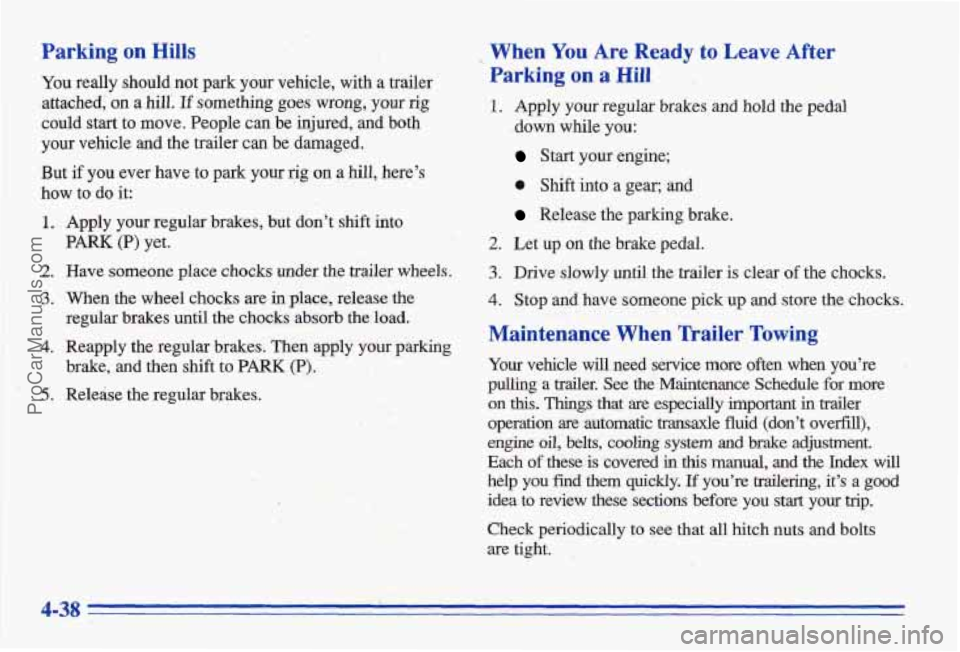
Parking on Hills
You really should not park your vehicle, with a trailer
attached,
on a hill. If something goes wrong, your rig
could start to move. People can be injured, and both
your vehicle and the trailer can be damaged.
But
if you ever have to park your rig on a hill, here’s
how to do it:
1. Apply your regular brakes, but don’t shift into
2. Have someone place chocks under the trailer wheels.
3. When the wheel chocks are in place, release the
regular brakes
mil the chocks absorb the load.
4. Reapply the regular brakes. Then apply your pa;rking
brake, and then shift to PdRK (P).
PARK (P) yet.
’ 5. Release the regular brakes.
~ When You Are Ready to Leave After
Parking on a Hill
1. Apply your regular brakes and hold the pedal
.down while
you:
Start your engine;
e Shift into a gear; and
Release the parking brake.
2. Let up on the brake pedal.
3. Drive slowly until the trailer is clear of the chocks.
4. Stop and have someone pick up and store the chocks.
Maintenance When Trailer Towing
Your vehicle will & service more often when you’re
pmg a trde~ See the Mainte~nance Schedule for more
on this. Things that are especially important in trailer
operation are .automatic
trande fluid (don’t overfill),
engine
oil, belts, cooling system and brake adjustment.
Each
of these is-covered in this manual, and the Index will
help you kd them quickly. If you’re tradering, it’s a good
idea to review these sections before you start your trip.
Check periodically to see that all hitch nuts and bolts
are tight.
4-38
ProCarManuals.com
Page 222 of 387
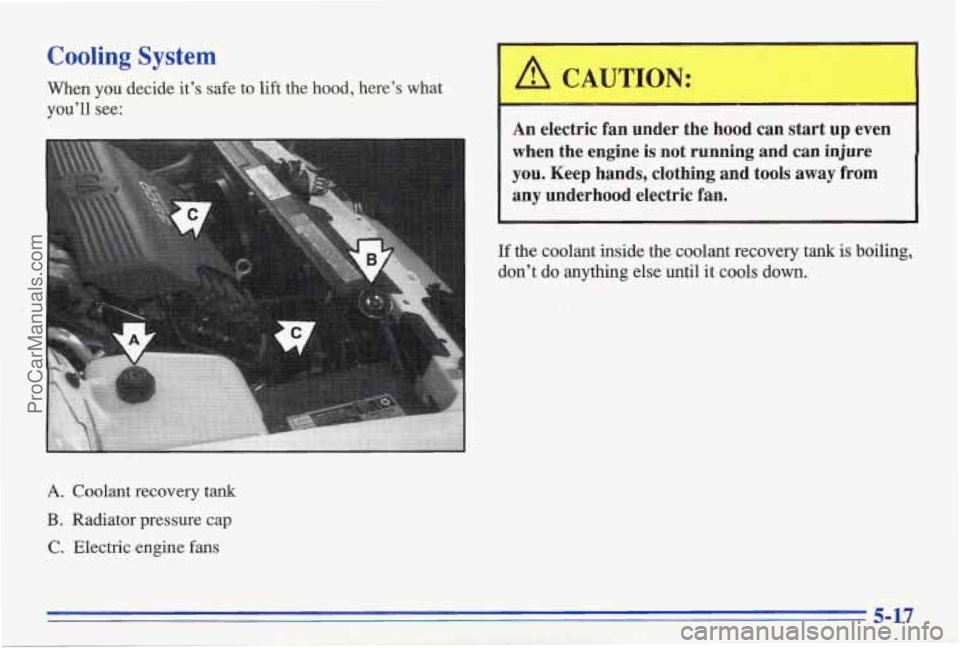
Cooling System
When you decide it's safe to lift the hood, here's what
you'll see:
C
An electric fan under the hood can start up even
when the engine is not running and can injure
you. Keep hands, clothing and tools away from
any underhood electric fan.
If the coolant inside the coolant recovery tank is boiling,
don't do anything else until it cools down.
.
A. Coolant recovery tank
B. Radiator pressure cap
C. Electric engine fans
5-17
ProCarManuals.com
Page 223 of 387
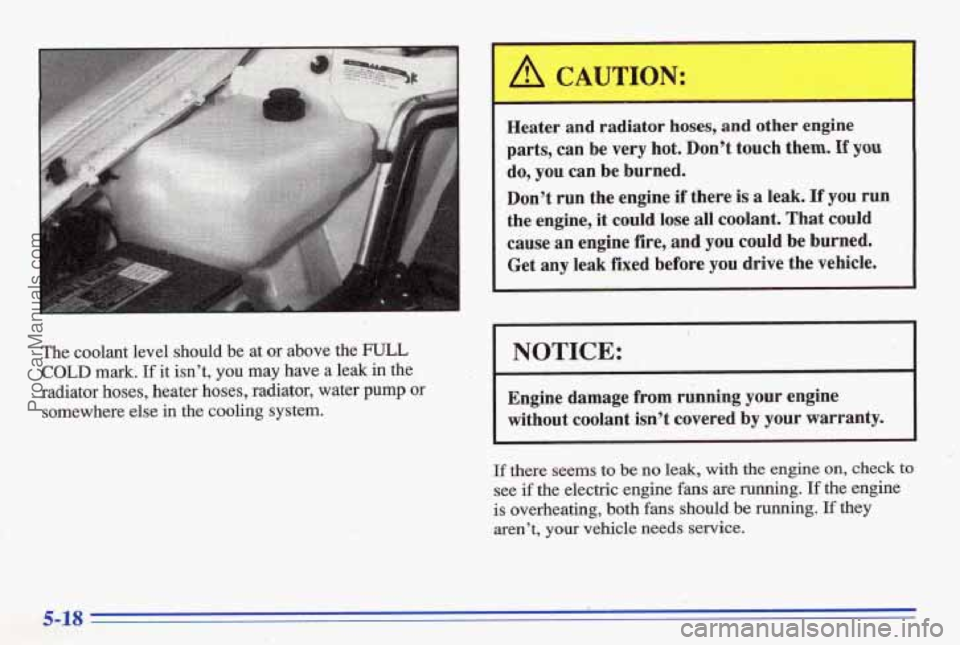
,
‘The coolant level should be at or above the FULL
% COLD mark. If it isn’t, you may have a leak in the
. radiator hoses, heater hoses, radiator, water pump or
somewhere else in the cooling system.
A CAWTION:
Heater and radiator hoses, and other engine
parts, can be
very hot. Don’t touch them. If you
do, you can be burned.
Don’t mn the engine
if there is a leak. If you run
’ the engine, it could lose all coolant. That could
cause an engine
fire, and you could be burned.
Get any leak fixed before you drive the vehicle.
I NOTICE:
I
Engine damage from running your engine
without coolant isn’t covered by your warranty.
I
If there seems to be no leak, with the engine on, check to
see if the electric engine fans are running. If the engine
is overheating, both fans should be running. If they
aren’t, your vehicle needs service.
ProCarManuals.com